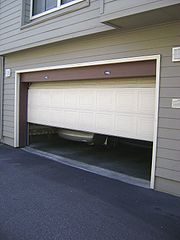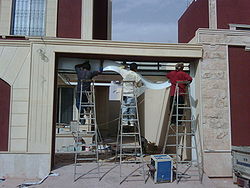


A garage door is a large door
on a garage
that can either be opened manually or by a garage door opener
. Garage doors are necessarily large to allow passage of automobile
s and/or truck
s.
Description
A typical overhead garage door consists of several panels hinged together that roll along a system of tracks guided by rollers. The weight of the door is balanced by either a torsion spring system or a pair of extension springs.History
The upward-lifting garage door was invented in 1921 by C. G. Johnson, who also invented the electric garage door opener in 1926. Leno Martin is credited with inventing one of the first one- piece overhead type garage doors in 1936.Single panel garage doors
Single panel doors are constructed from one monolithic panel. From the closed position a single panel door will slide up and overhead on rails to the fully open position. A disadvantage of monolithic panel doors is that the swing up arc of the door occurs partially outside the garage. This means a vehicle must stop and park several feet in front of the door to avoid being hit by the garage door when it is opened.Sectional garage doors
Sectional doors are usually constructed of six to eight panels and slide up and overhead. Sectional doors occupy exactly the same amount of internal garage space as a monolithic door. Sectional doors have two distinct advantages over single panel monolithic doors:- Sectional doors do not require any space outside the garage to open. A vehicle may park very close to the garage before opening the door.
- Each panel of a sectional door has its own connection to the door track. This increases reliability and robustness compared to monolithic doors which have only a couple of track connections for the whole panel.
Garage doors can be made out of many materials, but steel
, aluminum, wood
, and vinyl
(polyethylene
) are the most popular materials. A few manufacturers are making garage doors by putting foamed-in-place polyurethane insulation in monolithic panel and sectional garage doors.
Roller doors
Roller doors are usually constructed of corrugated steel. Other materials can be used (eg; transparent corrugated fibreglass) where strong impact resistance is not required. Corrugations give the door strength against impacts. A typical single car garage roller door will have a preloaded spring inside the rolling mechanism. The spring reduces the effort required to open the door. Larger roller doors in commercial premises are not sprung and use a manual pulley and chain system or a geared motor to raise and lower (roll up and roll down) the door. Roller doors cannot be effectively insulated.In the UK (and other parts of the EU), 'insulated' roller garage doors are available, using an aluminium lathe which is then foam filled, which not only adds thermal but acoustic insulation.
Materials and insulation
A common material for a new garage door is steel sheet formed to look like a raised panel wooden door. Steel doors are available in uninsulated, insulated, and double skin steel. A design mimicking carriage housedoors has become popular since about 2002, and many manufacturers clad the exterior of a steel door with composite, vinyl boards, or DecamTrim to give it the appearance of wood. Steel carriage doors are becoming the most popular carriage door due to weight of the door, no rotting, and a large amount of designs. A more economical alternative for garage doors is steel stamped construction.
Torsion spring lift mechanism
A torsion springcounterbalance system consists of one or two tightly wound up springs on a steel shaft with cable drums at both ends. The entire apparatus mounts on the header wall above the garage door and has three supports: a center bearing plate with a steel or nylon bearing and two end bearing plates at both ends. The springs themselves consist of the steel wire with a stationary cone at one end and a winding cone at the other end. The stationary cone is attached to the center bearing plate. The winding cone consists of holes every 90 degrees for winding the springs and two set screws to secure the springs to the shaft. Steel counterbalance cables run from the roller brackets at the bottom corners of the door to a notch in the cable drums. When the door is raised, the springs unwind and the stored tension lifts the door by turning the shaft, thus turning the cable drums, wrapping the cables around the grooves on the cable drums. When the door is lowered, the cables unwrap from the drums and the springs are rewound to full tension.
Life of torsion spring
Most garage door manufacturers, garage door dealers, either produce and sell garage doors fitted with torsion springs that have a minimum of 10,000 - 15,000 cycles which is estimated to last between 3 to 7 years. However, it is important to remember that if the weight of the garage door is increased by adding glass, additional insulation, or even several coats of paint, the life of the torsion spring may be greatly be reduced.Other factors like poor garage door maintenance, loose tracks, or components will shorten the life of torsion springs. Owners are advised to avoid applying grease to the garage door tracks, this will prevent the wheels on the rollers from doing their job. Only the bearings, hinges, and spring wire require lubricant.
Extension spring lift mechanism
An extension spring counterbalance system consists of a pair of stretched springs running parallel to the horizontal tracks. The springs lift the door through a system of pulleys and counterbalance cables running from the bottom corner brackets through the pulleys. When the door is raised, the springs contract, thus lifting the door as the tension is released.Maintenance
The balance of the door should be checked monthly. One should be able to raise and lower the door without any resistance and it should smoothly roll along the tracks and should remain stationary at any point of travel. Usually a door that does not pass these tests is out of balance and should be adjusted.All moving parts of the door should be lubricated monthly. The door tracks should never be lubricated since the lubricant will only create a sticky surface on the track that can attract more dirt and grime, resulting in a door that is really difficult to operate. The bearings, hinges, and rollers should be lubricated for proper and safe operation. Torsion springs should also be lubricated with a light coat of oil to reduce the friction between the coils and to eliminate any noises and to even increase the life of the springs.
Safety
Garage doors with extension springs would normally be installed with a restraint cable running through the center of these springs. This is necessary because the springs weaken from the fatigue and stress exerted on the steel wire from opening and closing the door. If an extension spring breaks, it can seriously injure anyone present in the garage or damage adjacent property. The cable running through the center restrains the spring in the event of a failure.Most overhead garage doors are equipped with torsion springs which do not need safety restraint cables since the torsion shaft running through the springs restrains the spring if it breaks. Torsion springs are superior to extension springs since they are easier to fine tune and balance the weight of the door more evenly. However, torsion springs can be life threatening to an unsuspecting homeowner trying to replace a spring or fix the center spring support bracket.
The bottom roller brackets located at the bottom corners of the door are always under extreme tension since the counterbalance cables are attached to these brackets. Therefore, one should never attempt to remove or loosen the screws that attach these brackets to the door as serious injury can result. This also applies to other spring hardware such as the setscrews, cable drums, lag screws, lift cables, etc.
Springs that lose tension or relax over time can pose a significant danger if the garage door is released from the opener, while in the up position---potentially leading to a free falling door.
Safeguarding against dropping of vertically operating doors
This requirement states that doors must be designed so that a failure in the suspension system (typically springs) will not result in the door dropping uncontrollably. Properly designed doors achieve this by employing an anti-drop device or multiple springs so that the failure of one does not result in door falling with a guillotine effect.
Resistance to wind load
Doors must be rated according to their capacity to resist wind as doors damaged in this way pose an immediate danger. This is especially important for doors with a large surface area. The EN norms dictate that doors must carry a rating from I to IV, with IV being the highest rating possible.
Uncontrolled movement
The door should have a brake or balance system that automatically engages when the door movement is stopped in any position. The closing edge of the door should never exert force of more than 150 Newtons (15KG), even after a motor or spring failure.
Closing Gaps
Mechanical features of the door must be designed to prevent the risk of cutting, crushing or shearing during the operation of the door, up to a height of 2.5m. Gaps should be designed out of the door or guarded with suitable warnings if this has not been achieved. For example, holes for locking devices should be guarded so that the door itself does not become a heavy shear.
The Machinery Directive
When a door is automated, it is classed as a machine under the machinery directive. To safely control such a large, heavy object, door openers must be equipped with features which will stop the door before any damage can occur. This is generally achieved via sensitive reversing systems or non-contact photo-eyes which stop the door before a person or obstruction is touched.
CE compliant doors, installed by factory trained specialists are good value. Well designed doors will give you fifteen years or more of reliable service and cost little or nothing over doors that may put users at risk and affect your insurance coverage.
In Ireland and the UK, The Door and Hardware Federation (DHF) is the trade association for the garage door industry. The DHF is a member of the European Door and Shutter Federation, the body responsible for developing the door safety standards across Europe. Manufacturers who carry the DHF logo on their brochures have signed up to their Code of Practice which includes certification that all of their door and opener products are CE compliant. To legally carry the CE mark, all products must be tested by independent “notified bodies” such as BRE in Britain and SP in Sweden. The DHF logo is your assurance of safety, compliance and quality.
Another key safety concern with a garage door involves the section joint and other gaps or entrapment points on a door. The Consumer Product Safety Commission estimates there are as many as 20,000 injuries a year related to garage door use in the United States.

